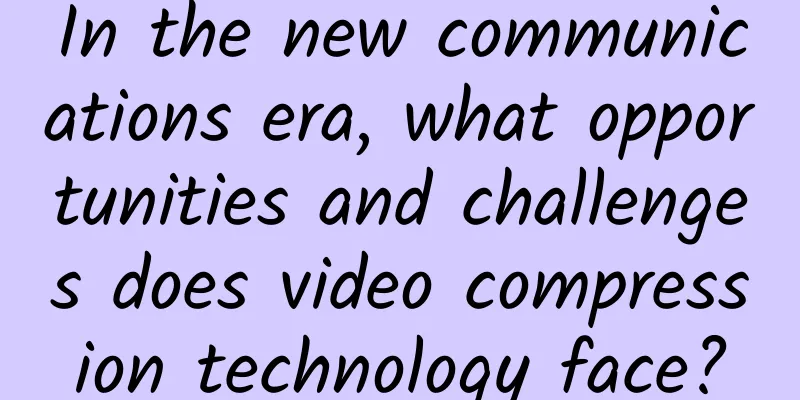In the new communications era, what opportunities and challenges does video compression technology face?

|
With the development of communication technology, the number of Internet and mobile Internet users has been growing steadily. As an important component of network applications, the proportion of video applications has gradually increased. As of December 2016, the scale of online video users in China reached 545 million, an increase of 40.64 million from the end of 2015, with a growth rate of 8.1%. Among them, the scale of mobile video users is close to 500 million, an increase of 94.79 million from the end of 2015, with a growth rate of 23.4%. Video compression technology ushers in important development opportunities l User needs are diverse. With the development of live broadcasting for all and the formation of short video viewing habits on mobile phones, the scale of online video and mobile online video users has increased significantly. The application of popular technologies such as VR and AR in the video field has also brought new experiences. With the improvement and innovation of future technologies, it will surely promote the transformation of more video applications.
Among them, in terms of hardware, Socionext launched the world's first chip sample MB86M31 that supports real-time 4K/60P HEVC encoding; MediaTek released the world's first H.265/HEVC codec LS for smartphones; Realtek launched the world's first DivX® HEVC certified chip to promote 4K streaming on UHD TVs. In terms of codecs, Thomson Video Networks launched the real-time HEVC 10-bit encoder ViBE4K for UHD broadcasting; VITEC's portable HEVC-IP decoder MGW D265; BBright's UHD HEVC live encoder; SK Telecom and Pixtree jointly developed a real-time HD hardware HEVC encoder, etc. In terms of products, multimedia products are currently expanding support for HEVC, such as NVIDIA GeForce GTX 960 graphics cards; NEXCOM's latest security monitoring products and cameras; Infomir's new set-top boxes MAG257 and MAG350, etc. Spectrum and patent rights challenges cannot be ignored With the continuous implementation of "speeding up and reducing fees", short videos have led to a significant increase in the scale of mobile network video users. On mainstream apps such as WeChat and Weibo, users' behavior of watching short videos has become more common. Although network transmission speeds continue to increase, there is still a gap between theoretical bandwidth and actual experience bandwidth; people's needs continue to increase, and the number of users is also growing steadily. People's pursuit of video application experience requires video compression technology with better compression performance to meet it. For example, the application of technologies such as VR and AR in the video field has brought a new video experience. At the same time, the application of this 360-degree panoramic video also requires the support of superior video compression technology. On the one hand, investors and operators want to reduce costs and carry more services, and end users also hope to reduce usage fees; on the other hand, spectrum resources are non-renewable; this requires the development of multimedia technology and the improvement of the compression performance of video compression technology, thereby increasing the economic value created by the channel unit spectrum. In addition to the challenge of spectrum scarcity, communication and video compression technologies also face the challenge of patent rights. Before the full promotion of HEVC, the battle for HEVC patent rights has quietly begun. In addition to MPEG LA, which owns the patent rights of HEVC, HEVC Advance announced the establishment of a new HEVC patent pool in March 2015. The preliminary list of its licensees includes GE, Technicolor, Dolby, Philips and Mitsubishi Electric. Technicolor withdrew from HEVC Advance in 2016 and directly licensed its HEVC intellectual property portfolio to equipment manufacturers. The instability of patent collection groups has led to disputes over patent ownership, and the huge patent fees have also affected the development of video compression technology. HEVC Advance launched a patent fee charging standard in July 2015, but later revised the fee standard in December 2015 due to excessive fees. Due to the opacity of HEVC patent licensing policies and complex patent ownership issues, many companies are afraid to widely adopt HEVC, a new video compression standard. These problems also need to be solved by the industry. |
<<: Will the countdown to 3G shutdown trigger a wave of phone replacement across all networks?
>>: 2017Q1 China Wireless Router Market Research Report
Recommend
F5: How does edge computing change the digital banking experience?
[[408931]] A report jointly released by IDC and B...
Network Access Control-Network Address Translation
With the development of the Internet and the incr...
DMIT Triple Network CMIN2 Backhaul $39.9/year-1GB/10G SSD/800GB@1Gbps/Los Angeles Data Center
DMIT.io has newly launched the LAX EB series of C...
What will happen to 5G base stations if power is cut off? Can operators handle the performance?
Power outages are happening all over the country,...
What is SDON?
This article is reprinted from the WeChat public ...
Maxthon Hosting: 56 yuan/month Hong Kong CN2-2GB/40G SSD/300GB/15M Bandwidth
Aoyo Zhuji is one of the foreign hosting services...
5G, IoT and AI: Art and tech jobs for 2021
We are witnessing a massive transformation in the...
In the era of intelligence, computing power is upgraded, and Huawei Cloud enables the intelligent transformation of the industry
[51CTO.com original article] Recently, Huawei hel...
The base station power consumption is too high and the charges are 9 times higher than 4G. Are the operators facing a big problem this time?
Previously, China Unicom officially announced tha...
Next-generation network management is difficult without AIOps
AI for operations, or AIOps platforms, is the in...
How high-quality infrastructure helps data centers cope with business disruptions
As today's corporate organizations are active...
my country's optical chip technology upgrades accelerate the proportion of optical devices to rise year by year
Optical chips and optical components are the basi...
DediPath Summer Promotion: Los Angeles E3 servers start at $39 per month, New York servers start at $49 per month
DediPath has released its latest summer promotion...
[Restock] Bricklayer Los Angeles CN2 GIA (DC6/DC9)/Japan Softbank special price $46.6/year
Bandwagonhost has restocked the special annual pa...
What exactly is “cloud-network integration”?
Hello everyone, today I would like to talk to you...








![[11.11] Megalayer: 50% off on regular VPS, Hong Kong/Philippines/US VPS starting at 159 yuan per year](/upload/images/67cac22f4c904.webp)
